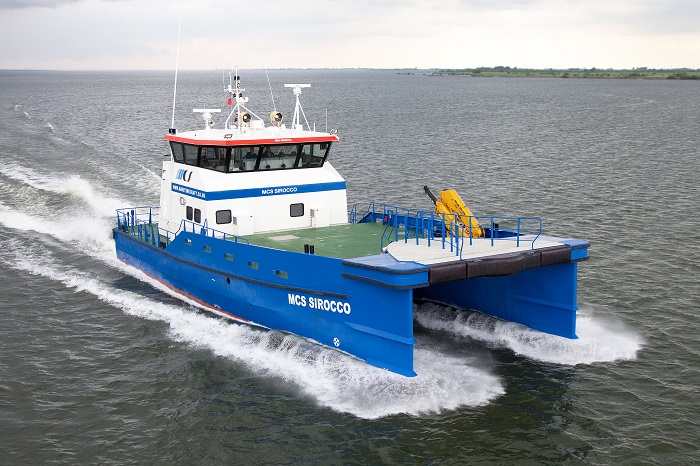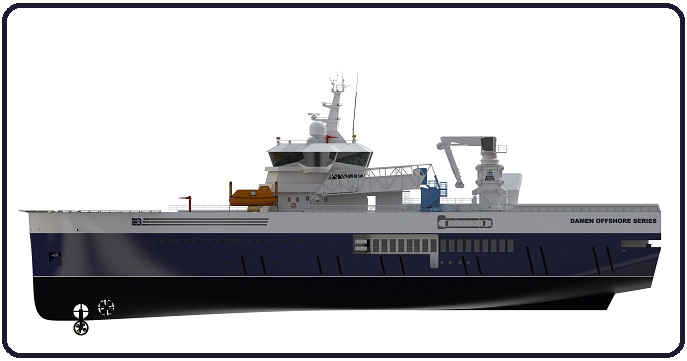Editor’s note: The European offshore wind industry is just a little ahead of the nascent U.S. version. For the next few years, the U.S. companies will be building the infrastructure to support the offshore turbines with equipment such as the vessels featured in this article. They are from The Netherlands-based ship builder Damen. The article lets us take a brief tour of one of the ships that will carry O&M crews from shore to work and back. Later in the article, company executives tell how the company streamlines its processes to deliver a new ship in about a month.
Offshore wind farm installation work is growing rapidly off the coast of North West Europe, creating high demand for support vessels that can move quickly between sites to deploy maintenance engineers and equipment.
Around 100 vessels of various types are in operation within the region with 30 more under construction. With the industry pushing to develop locations over 20 km from coasts at depths exceeding 20m, a distinct market for multifunctional service and accommodation vessels for offshore wind is fast emerging, requiring reliable and safe operations in dynamic conditions.

The line of Twin Axe vessels from Damen sport twin hulls for stability in rough seas and a hull design that allows fast transits, to 26 knots.
In line with its expanding offshore vessel portfolio, Damen Shipyards has targeted wind-farm support as a strong growth opportunity. Its High Speed Craft group is now a priority in a review of Damen’s entire production processes, through which it is identifying its strengths and weaknesses to optimize ‘smart’ delivery practices.
Damen has already been making significant inroads in the niche wind-farm market. It has supplied 27of its Twin Axe Damen FCS 2610 vessels (25.6-m length overall, 10.27-m beam, 2.2-m draft) since its introduction three years ago, with four more due for delivery. The vessel provides a stable platform for transferring personnel to and from offshore installations in wave heights of 2.5m. What’s more, the ship can hit a maximum speed of 26 knots and has a range of 1,200 nautical miles.
With accommodations for eight crew and transport capacity for 12 passengers, the FCS 2610 features an extended wheelhouse and fore sections designed to ‘dock’ with an offshore structure. End users include early wind farm support specialists Marineco, Maritime Craft Services, Seaconsult, Seazip, Sun Wind, and Windea Offshore.
Predicted wind
Companies involved in wind-farm support have a variety of roots but, once they require vessels, they all need them delivered quickly. Joost Mathôt, Damen High Speed Craft Program Manager explains: “The market is different to what one might expect. Contract terms are comparatively short – five years and below. In practice, tenders for support vessel operations are issued only shortly before full scale operations are due to commence.
“Getting the maintenance technician to the wind farm is not the first thought in the mind of field developers, and that puts vessel operators under pressure to deploy quickly when the time comes. This is a new market and the right type of vessel is not always available in the given timeframe, and then the vessels delivered must be flexible enough to transfer to other projects and duties.”
High demand for the Twin Axe FCS 2610 has already prompted the company to build the vessel type for stock. The approach lets it fulfill a recent contract with Danish operator Sea Consult, with delivery of an FCS 2610 vessel a month after signing the initial letter of intent.
Consultative process
Standardization and the building-to-stock philosophy is an established practice at Damen. However, its latest ‘smart’ review looks to develop a harmonized approach that optimizes the complete process from design to delivery, rather than basing the practice on short-term market expectations.
‘Smart’ review conclusions have already been adopted within Damen’s core tug business. As part of the HSC Group review, Damen has consulted widely with its wind farm support vessel customers on experience, expectations, and requirements, to establish a standard menu for design choices.
“To accelerate the outfitting and finishing stages, we switch from a project-oriented to a process-oriented production scheme,” says Mathôt. “The review offeres the opportunity to optimize the overall design at the same time as we considered how best to take a systematic approach, so we could offer variety suitable for the operating profiles that operators will encounter.”
The result is “smart customization”, says Mathôt. “At the moment, customers will say they want a modification and then expect to find it on the next vessel delivered within the same contract. That is frustrating for both sides. By formalizing the process at the outset, we can take feedback into account, with expectations clear on both sides.”
Thus, ‘smart’ ship designs develop in the same way that car designs evolve, with the smoothing-out of production given priority until accumulated feedback prompts the launch of ‘the next generation’ vessel.
Ronald Boerman, Damen Shipyards Gorinchem Project Manager explains an interactive sales process wherein the potential customer answers predefined questions to arrive at a base design that will meet operating requirements. “Such questions could include proposed country of operation, expected climatic conditions, the requirement for a shipboard crane, requirements on hull coatings, and so on,” he says.
“For example, if the customer decides that a ship design satisfies performance requirements overall but favors a specific crane, this information can be factored in at the outset. Internal arrangements can then be modified so that the appropriate platform is in place.”

Damen recently unveiled this new concept vessel for offshore windfarm maintenance support – the Walk-to-Work vessel. The company has made market inroads with its FCS 2610, which needs a crew of eight and can transport up to 12 wind technicians and equipment to work offshore. The W2W vessel features its own transfer gangway and targets maintenance work further offshore. It will have capacity and accommodation for 30 technicians. Good video explaining the design here: http://products.damen.com/en/ranges/walk-to-work-vessel
Filling out the form
Striking a balance between series production and tailor-made vessels is an important consideration given that one of the oddities of wind farm development has been its ‘national’ flavor.
“If one vessel operates in a particular regime and the next ship is basically to the same design but operating under another administration, finishing ships at the last minute can lead to delivery inefficiencies,” says Boerman. “If we know the requirements of each administration in advance, we can factor that into a rationalized production process.”
“The idea of ‘smart customization’ has been readily accepted in the tug sector,” says Mathôt. “From the first quarter of 2015, we will be making the same offer in the wind farm support sector. The basic concept is for owners to select ‘design-by-adding’ options, rather than modifying the base range to meet specific needs.”
Boerman says that, even in relation to accommodation areas, appropriate solutions are found within one basic design “augmented by a number of options and available upgrades.”
Popular variation
“By analyzing the variety of vessels in the market, we have arrived at definitions of the most popular variations,” says Boerman. “If we look at the issue of cranes again, closer questioning can reveal that it is not necessary to position the crane exactly where the owner envisaged so a more standard design could be accepted.
“We are not suggesting that we limit our offer to standard vessels. But if the customer sticks within the menu, he can benefit from clarity on pricing,” he adds.”
“It has always been a Damen trademark to deliver high quality ships on a tight schedule, but building to stock is no longer enough. The devil is in the detail and one of the keys involves harmonizing activities at the point where design production and output come together.”
Filed Under: News, O&M, Offshore wind




